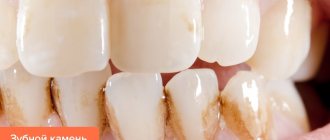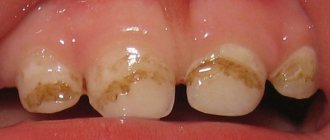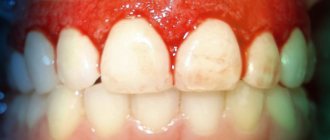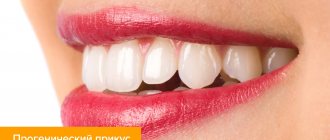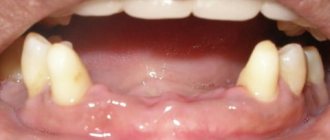Tartar formation and complications of this condition are one of the most common reasons for visiting a dentist. But not everyone knows that the appearance of this unaesthetic plaque can be prevented, and that prolonged absence of treatment for already formed stone can lead to tooth loss.
Experts diagnose almost all people with tartar, the treatment of which, as a rule, is quite expensive. To understand how you can avoid this problem, you need to understand what tartar is and how you can prevent its occurrence.
What is tartar
Tartar is hardened soft plaque. When brushing teeth incorrectly or poorly, a soft mass consisting of fragments of the mucosal epithelium, food particles and colonies of bacteria accumulates on their surface and in the interdental spaces. Under the influence of saliva and substances produced by bacteria, the mass gradually hardens, turning into tartar. Hard deposits may be observed on the back surfaces of teeth and between teeth, in which case they are classified as supragingival calculus. Gradually, under the influence of gravity and chewing movements, the stones move under the mucous membrane of the gums and are classified as subgingival.
How is tartar removed?
At the Dentospas clinic, tartar removal is performed as a separate procedure or as part of professional comprehensive oral hygiene. We use several methods for this:
- mechanical. A special tool is used for this. These can be curettes, hooks of various shapes, hand scalers. Mechanical cleaning is carried out with a large thickness of solid deposits or for individual areas where their formation is accelerated. It is usually supplemented in other ways to improve the result and ensure a gentle effect on hard tissues;
- ultrasonic. The main method of removing soft and hardened plaque. Under the influence of ultrasonic waves they are destroyed and easily peel off from the surface. However, it is not damaged. Ultrasound additionally destroys bacteria and microbes, which reliably protects against inflammation or infection. Can be used for the main, root part of the crown, for the surface under the gingival margin;
- Air Flow. A gentle cleaning method in which a mixture of air and an aqueous solution of sodium bicarbonate is sprayed onto the surface of the teeth under pressure. The procedure is effective in case of soft plaque and small accumulations of tartar (it is destroyed into a powder and washed off). Dentists at the Dentospas clinic recommend using it if professional hygiene is performed regularly and there is no large amount of hard deposits on the teeth;
- periodontal cleaning. It is performed using a combined method (mechanical and ultrasonic) if tartar accumulates under the gingival margin. For mechanical cleaning, special curettes are used. Cleaning with an ultrasonic scaler usually completes the procedure, disinfecting the periodontal pocket that was opened during the procedure.
The procedure has contraindications:
- pregnancy and lactation;
- a large number of fillings, restored, prosthetic teeth;
- installed braces and other artificial structures in the mouth;
- hypersensitivity of gums or enamel;
- diseases of the cardiovascular system, respiratory organs;
- infections, viruses, hepatitis.
The Dentospas clinic performs tartar removal and additional procedures (grinding, enamel polishing, fluoridation, application of protective varnish). The cleaning usually requires one visit to the dental hygienist and lasts about an hour. The procedure is painless, does not cause discomfort, and can be performed using anesthesia.
In what cases does stone plaque form?
The reason for the formation of tartar is poor quality dental care, in which soft plaque is not completely removed. High mineral content causes plaque to harden. Using a too soft toothbrush, lack of attention to the interdental spaces and gum margins, irregular oral hygiene, etc. are the main sources of the problem.
But there are factors that increase the likelihood of hard deposits forming on teeth:
- diseases of the digestive system and endocrine system, in which the chemical composition of saliva changes;
- malocclusions and dental defects that form particularly difficult areas to clean;
- wearing dentures, braces, brackets, plates and other structures that make it difficult to properly clean teeth using a traditional brush and paste;
- a large amount of carbohydrate foods in the diet, which facilitates the gluing of soft plaque particles.
Prices for professional teeth cleaning:
| Comprehensive professional hygiene | Air Flow cleaning, ultrasonic tartar removal, enamel polishing and fluoride varnish coating | 5000 rubles |
| Comprehensive preventive professional hygiene | for patients who have undergone the procedure for no more than 6 months. Air Flow cleaning, ultrasonic tartar removal, enamel polishing and fluoride varnish coating | 2500 rubles |
| Fluoride varnish coating | in the area of one tooth | 100 rubles |
| Polishing and fluoridation of teeth | in the area of the teeth of two jaws | 2500 rubles |
| Professional hygiene of the oral cavity and teeth using the “AIR-FLOW” sandblasting machine | in the area of the teeth of one jaw | 2500 rubles |
| Professional hygiene of the oral cavity and teeth using the “AIR-FLOW” sandblasting machine | in the area of one tooth | 380 rubles |
| Ultrasonic removal of supragingival and subgingival dental plaque | in the area of one tooth | 200 rubles |
| Comprehensive professional hygiene | Air Flow cleaning, ultrasonic tartar removal for orthodontic patients | 6000 rubles |
Kinds
Plaque is divided into two categories. First, supragingival stone appears, the cause of which is poor oral hygiene. Such deposits are located above the upper edge of the gingival crest, so they are easily diagnosed during a routine examination.
The characteristic features of supragingival tartar include:
- Localization on the inner surface of the tooth, from the side of the tongue;
- White or yellowish tint;
- The consistency is hard or clay-like.
The plaque is unstable, so it can be removed mechanically without any problems.
Subgingival calculus appears as a result of the fact that supragingival plaque descends down the root of the tooth and mineralizes. It forms in the gum pocket and is diagnosed only when using special dental instruments. Such deposits are considered age-related and most often appear in people over 40 years of age. If personal hygiene rules are not followed, it can appear at any age.
Signs of tartar:
- Dense and hard consistency;
- Light brown or greenish-black tint;
- Swelling and bleeding gums.
Tartar: causes of appearance
Leftover food in the mouth after eating is a favorite treat for bacteria. Such microorganisms especially love the so-called “fast” carbohydrates, found in large quantities in flour products and sugar. It has been proven that even if oral hygiene is neglected one day, this will lead to accelerated plaque formation, increasing in volume several times over this period of time.
Bacteria need nutrients both to maintain vital processes and to produce enzymes that allow them to securely attach to the tooth surface. If you brush your teeth poorly, individual bacteria will begin to form colonies, which, in turn, can also merge with each other. Nevertheless, at this stage, eliminating plaque is not yet particularly difficult - you can get rid of it by working well with a toothbrush.
Over time, the plaque will mineralize (calcium salts and proteins present in saliva will begin to settle on the surface of the bacteria, which will proceed in parallel with the formation of new colonies), hardening and increasing in volume.
At the same time, toxins will be released from the plaque, causing the development of the inflammatory process. You can understand that inflammation has begun by pain in the gums, their bleeding during brushing, the flow of pus and increased tooth mobility.
The inflammatory process is of great importance for bacteria: the groove between the gum and tooth constantly receives liquid rich in proteins necessary for bacteria to grow; inflammation increases the formation of this fluid, accordingly, microorganisms receive more proteins, and the growth rate of their colonies becomes higher.
Concluding all of the above, the appearance of a stone is a direct consequence of non-compliance with hygiene.
Symptoms of Tartar
The first symptoms of tartar are a change in the color of the enamel on the upper molars and lower incisors. Soft yellow or gray plaques appear. First of all, tartar forms in areas where there is no self-cleaning of the surface during the process of chewing food or rinsing: the interdental space, the inner walls of the tooth.
Primary symptoms:
- Bad breath;
- Mild itching of the gums;
- Slight bleeding.
If no measures are taken to remove plaque, it begins to mineralize, becoming harder. As a result, the gums may become inflamed and there will be severe swelling and redness. Detachment of the gingival margin is possible, which leads to the appearance of a periodontal canal.
Reasons for education
Dental calculus is also dangerous because it is not immediately detected. Depending on the location of deposition, the stone can be supragingival or subgingival. The first option is more common and is easier to identify during the initial examination at the dentist. The location of the hardened plaque in this case is above the gum, around the crown of the tooth. In the second option, the plaque is located inside the gum and adheres tightly to the tooth. Until it begins to cause discomfort and health problems, it is quite difficult to identify it.
You can suspect a problem based on the following signs:
- The appearance of persistent bad breath.
- Increased sensitivity of some teeth.
- Swelling, pain, discomfort of the gums, especially between the teeth.
- Changing the shade of tooth enamel, the appearance of stains on it.
- Bleeding gums.
There are several reasons for the formation of stone on teeth.
Among them:
- Insufficient oral hygiene.
- Lack of preventive measures.
- Incorrectly selected toothbrush (too soft or, conversely, hard).
- Malocclusions and other orthodontic problems.
- Smoking.
- Abuse of sweet foods and sugary carbonated drinks.
- Too little or no solid food in the diet.
- Drinking too little water per day.
- Endocrine disorders and metabolic disorders.
The most pressing cause of stone formation is insufficient dental hygiene. Hygiene is often neglected by children and teenagers, so it is important for parents to remind them of the need for brushing and to visit the dentist regularly.
What are the dangers of tartar?
In cases where tartar has already formed, treatment should be carried out immediately. Otherwise, it moves under the gums and leads to severe disorders of tissue metabolism in soft tissues.
As a result, acute or chronic gingivitis develops, the ligamentous apparatus of the tooth becomes inflamed and, as the most severe complication, periodontal disease develops - atrophy of the tissues that provide support to the tooth. As a result, a person who has developed subgingival tartar in the future faces the need to remove teeth that have lost stability and are no longer able to perform their functions.
Methods for treating tartar
Treating tartar on your own at home is not possible. Tartar removal is performed using practical and painless methods in the dentist’s office:
- Ultrasonic cleaning. This is the treatment of tartar with a scaler. The equipment generates low-frequency ultrasonic vibrations that destroy dental plaque. After this, the dentition is washed with a stream of water, and the enamel is ground and polished.
- Air Flow whitening system. In this case, cleaning is performed with an abrasive compound supplied under pressure through a special nozzle. The composition includes air, water and sodium carbonate. The equipment does an excellent job of cleaning the interdental space and effectively removes stubborn plaque.
- Laser cleaning. This is a non-contact technique that does not cause discomfort or pain. Tartar cleaning is performed with a directed laser beam, the remaining particles are washed out of the oral cavity with a water-air jet.
Is it painful to remove tartar?
Let us assure you right away that in most cases this procedure is accompanied only by unpleasant sensations. However, each stone removal method has other advantages and disadvantages.
Tartars are small hardened particles of food in the form of dark-colored plaque. Tartar is formed due to the accumulation of food debris in the interdental spaces. They contain dead cells, calcium and iron salts, and various bacteria. To the question “Does it hurt to remove tartar?” does not poison your life, you should regularly brush your teeth and mouth, and also periodically visit a dentist for prevention.
However, if the hygiene procedure was skipped or not carried out carefully enough, food debris accumulates and hardens on the outside and inside of the tooth near the gum. These are dental stones. They can cause bad breath, bleeding gums, and the appearance of dark spots on the teeth. The result of the accumulation of pathogenic microorganisms is diseases such as periodontitis, gingivitis and caries - all of which often lead to the removal of damaged teeth.
Methods for removing tartar
In dentistry, three methods are used to get rid of tartar: mechanical, chemical and ultrasonic. Each of them has its pros and cons.
- Mechanical method Tartar removal involves manually cleaning teeth using a set of special dental instruments. When choosing this procedure, patients are interested in whether it is painful to remove tartar mechanically. Of course, this procedure cannot be called pleasant and relaxing: you will have to experience some discomfort. Mostly, the unpleasant sensations relate to the sanitation of the interdental space and periodontal pockets.
Pros Reliable and proven method, low cost compared to other methods.
Cons: Uncomfortable sensations, risk of microdamage (gums, enamel and soft tissues), increased sensitivity of the enamel.
- Chemical method getting rid of tartar involves treating damaged areas of the tooth with special chemicals - acids or alkaline solutions that soften and easily remove the tartar. This technique is used in cases of high tooth mobility, in cases of individual intolerance to other methods, in the presence of too dense and hard plaque on the tooth surface. Patients with thin and sensitive enamel, as well as hypersensitive gums, may experience unpleasant and even painful sensations.
pros An effective and fast method, can be used if mechanical cleaning is not suitable, teeth whitening by 1-2 shades, affordable price.Cons Exposure to aggressive chemical compounds can lead to the risk of damage to tooth enamel and cause increased sensitivity of the teeth; contact with the gums leads to inflammation of the soft tissues.
- Ultrasound method uses the power of ultrasonic vibrations, which have a destructive effect on tartar. The procedure is performed using a special device that generates ultrasonic waves of a certain frequency. To the question “Is it painful to remove tartar with ultrasound?” many patients respond that they did not experience any pain or discomfort during the procedure. To achieve a greater effect, after removing tartar, the doctor polishes the tooth surface and treats the teeth with a paste containing fluoride. Thanks to this, the result of ultrasonic cleaning is a snow-white smile that will last for a long time.
pros A reliable and painless method, the ability to whiten teeth by 1-2 shades, eliminates the risk of damage to the enamel, does not cause increased sensitivity of the teeth, the oral cavity is completely disinfected.Cons None, but there are limitations: the procedure is not recommended for women at the beginning of pregnancy, as well as for patients with serious diseases (tuberculosis, hepatitis, diabetes, chronic bronchitis and others).
Expert opinion
The most modern and safe way to remove tartar today is ultrasound - it is what is most often chosen by both patients and dentists.
This is a painless procedure with which you can not only clean the tooth surface, but also completely disinfect your gums, and even make your tooth enamel lighter. Ultrasonic cleaning does not guarantee teeth whitening by more than 1-2 shades, however, this is already a fairly noticeable and pleasant result. Before performing the procedure, it is imperative to consult a doctor - ultrasonic cleaning has contraindications, for example, such as severe enamel sensitivity, cardiovascular, pulmonary and other serious diseases.
How does an irrigator help with tartar?
One of the most frequently asked questions about whether an irrigator removes tartar can be answered this way: the irrigator helps with the prevention of tartar. It can only help if deposits have just begun to form and they have not yet formed stone. Regular and thorough brushing with a toothbrush and toothpaste, flossing, and completing your oral care with a irrigator can greatly reduce the risk of tartar.
But even in this case, tartar cleaning should be completed in the dentist’s office: the doctor will grind the enamel to eliminate roughness that facilitates the formation of plaque.
Why is tartar removal necessary?
Improving the condition of the enamel. Due to hard deposits, saliva stops washing the enamel, the process of mineralization, saturation with fluoride and other substances is disrupted. The enamel softens and becomes vulnerable to the formation of caries. Solid deposits have a porous structure. Pathogenic bacteria actively develop inside them. This can provoke an inflammatory process, infectious damage to the mucous membranes, and the development of gingivitis.
Diagnostics. The dentist can assess the condition of the teeth only after professional cleaning. If deposits have accumulated in a large volume and are not removed for a long time, whitish spots form underneath them (the initial stage of caries), which then darken. If there is specificity in the formation of plaque (forms only on one side, in certain areas, etc.), this may indicate a malocclusion or other problems with the condition of the teeth.
Prevention of gum disease. Areas near the gum line are difficult to clean, so plaque accumulates there faster. It can also form under the edge of the gum, which over time leads to inflammation. Regular professional dental cleanings help keep your gums healthy.
Reduced enamel sensitivity. Under tartar, the enamel demineralizes, its resistance to temperature and acid irritants increases, and high sensitivity appears (sensation of stinging, aching upon contact with irritants). Performing professional hygiene followed by fluoridation normalizes sensitivity and helps restore its normal state.
Do you have questions about tartar removal?
We will call you back within 30 seconds
+7
Prevention of tartar formation
The only reliable and effective means of prevention is control over the quality and regularity of dental and gum care.
Be sure to brush your teeth at least 2 times a day (morning and evening), ending each procedure with the use of an irrigator. This will help remove soft plaque from areas that traditional oral hygiene products cannot reach.
In addition, it is important to monitor your overall health, promptly seek bite correction and minimize the consumption of fast carbohydrates such as baked goods, sweets, etc.
More detailed information is presented in the catalog of oral irrigators.
Is it possible to get rid of tartar at home?
At home, you can solve the problem of dental plaque on your own. To do this, it is enough to change the brush (professional electronic brushes cope well with plaque), spend more time on oral hygiene, and use a mouthwash after brushing in courses. Since plaque is the first cause of stone formation, such attention will be an excellent prevention
If we are talking about already petrified plaque, folk methods and advice from the Internet can only visually reduce the problem. At the same time, for a cosmetic and, moreover, temporary improvement, you pay for the health of your teeth, the quality of their enamel and the high probability of relapses.
A dentist can help you get rid of tartar most effectively and safely. Modern techniques are gentle on enamel, help to thoroughly remove plaque and stone, and also prevent its recurrence.


